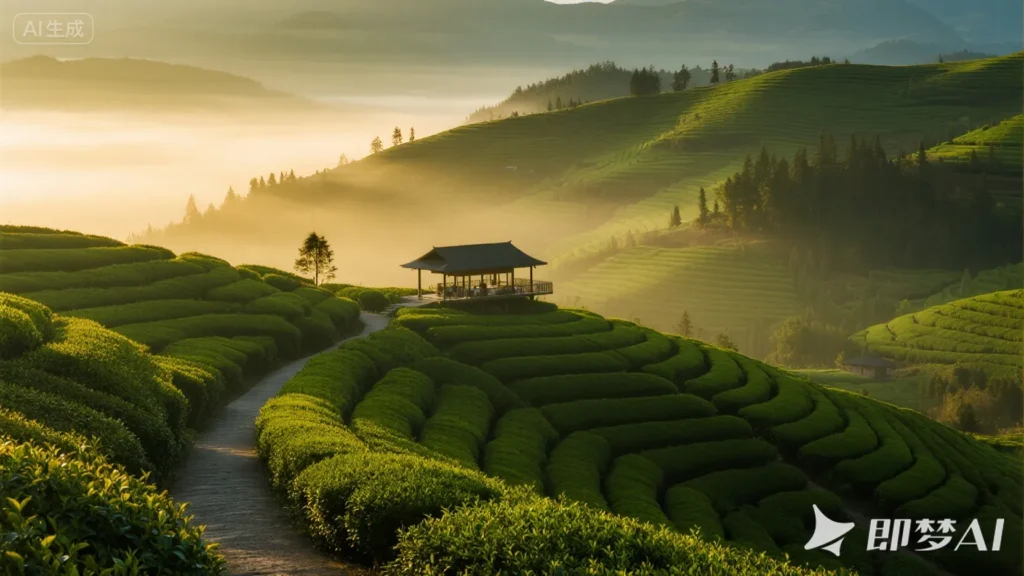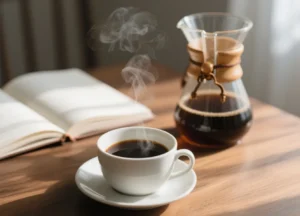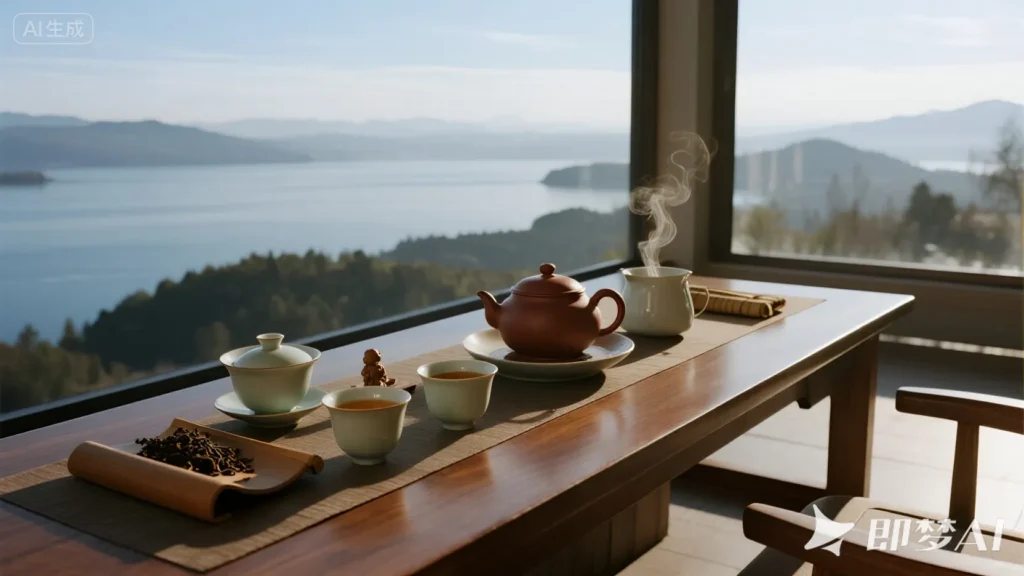
In China, the phrase “Have you eaten?” carries a deep sense of human care, where food and interpersonal connections are inseparable. However, beyond the delicious meals, a cup of clear tea is an indispensable presence in Chinese life. It’s not just a thirst-quenching beverage but also a vehicle for cultural heritage, carrying a long history, profound philosophy, and endless insights into life. As an old saying goes, “The myriad flavors of life are all in a cup of tea.” This article will take you on a journey from the ancient process of brewing tea, step by step, into the profound world of tea culture, exploring the life philosophies it embodies.
The Evolution of Tea: The Art of Brewing from Ancient Times to Today
The way tea is consumed has evolved over thousands of years, from the initial casual boiling of tea leaves to the gradual development of refined tea ceremony art.
Ancient Times to Early Tang Dynasty: Roughness and Flavorings Coexisted Before the advent of the Tea Sage Lu Yu, people drank tea very differently from today. In ancient times, fresh tea leaves were often mixed with rice paste to make tea cakes. When brewing, various seasonings like dried tangerine peel, red dates, and prickly ash were added, often masking the original flavor of the tea. In the early Tang Dynasty, flavored tea brewing was still popular, with salt and green onions added to the tea soup, enhancing the taste but sacrificing the tea’s inherent elegance.
Mid-Tang Dynasty: Lu Yu’s Boiled Tea, Poetry Infused It wasn’t until the Mid-Tang Dynasty that the Tea Sage Lu Yu introduced the revolutionary “boiled tea method” , bringing significant changes to tea drinking. His boiling steps included: first roasting the tea cake and letting it cool, then grinding it into powder with a tea mill, sifting it, and finally boiling it in water. The promotion of the boiled tea method transformed tea from just an everyday beverage into a medium for literati to express poetry and romance. Bai Juyi’s poem, “Sitting and pouring cool water, watching the rustling dust boil. There is no way to hold a bowl, to send it to the tea lover,” vividly depicts the passion people had for tea at that time.
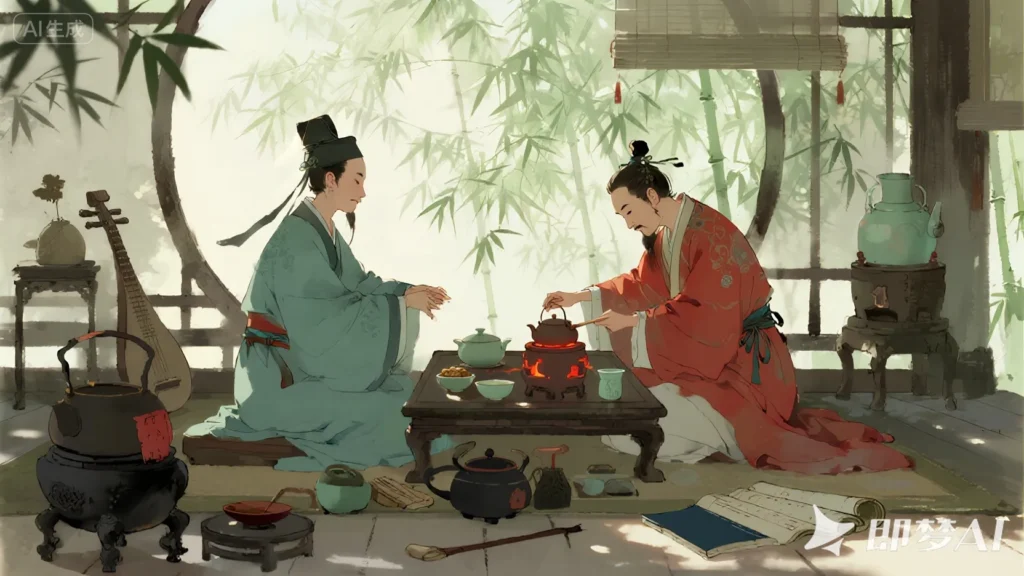
Song Dynasty: The Art and Zen of Whisked Tea By the Song Dynasty, the whisked tea method became the new trend, elevating tea drinking to an art form with its exquisite refinement. The process of whisked tea involved grinding tea cakes into fine powder, brewing them with boiling water, and then rapidly stirring with a tea whisk to fully integrate the tea powder and water, creating a delicate foam resembling “clouds piled with snow.” Song Dynasty whisked tea was not just for drinking but also an artistic enjoyment, influencing even Japan and becoming the origin of Japanese matcha culture.
Ming Dynasty to Present: Returning to Simplicity, Savoring True Tea Flavor After the Ming Dynasty, tea drinking methods were simplified again, and the steeped tea method emerged. Emperor Taizu, to curb the extravagance of tea consumption, ordered the abolition of compressed tea cakes and mandated tribute tea to be loose-leaf dried tea. He also simplified the tea-drinking process, emphasizing the tea’s natural flavor. Since then, people could choose tea leaves and teapots according to personal preference, and no seasonings were added during the brewing process. The focus shifted to “clear drinking,” pursuing the original flavor of the tea. This simple yet authentic brewing method has continued to this day, becoming the mainstream way of drinking tea.
The Core of Tea Culture: Philosophical Immersion of Confucianism, Buddhism, and Taoism
Chinese tea culture is not merely a material enjoyment; it’s also an elevation of spiritual wealth, profoundly integrating the essence of Confucianism, Buddhism, and Taoism, forming a cultural model about “how to be a person.” The natural attributes of tea and the essence of ancient culture permeate each other, giving tea rich spiritual connotations.
Confucianism: Harmony and Moderation, Self-Cultivation and Family Management Tea culture first integrated the Confucian concept of “harmony and moderation.” Confucianism advocates using tea to harmonize interpersonal relationships, achieving the ideal of mutual love, respect, and assistance. The honest and noble spirit of tea is used to temper one’s will, promoting “using tea for propriety and benevolence,” “using tea to show respect,” and “using tea to cultivate integrity.” This idea of “tea for cultivating ambition” encourages self-reflection, self-examination, and a clear understanding of oneself to correctly treat others. Its deeper meaning embodies the Confucian aspiration of “cultivating oneself, managing one’s family, governing the state, and bringing peace to the world.” In interpersonal communication, Confucianism emphasizes “the use of rites, harmony is precious,” through serving tea to guests, communicating thoughts and feelings, and enhancing friendship and social harmony.
- Taoist Philosophy: Unity of Heaven and Humanity, Tranquil Transcendence The origin of tea culture and Taoism is ancient and profound. Taoist “unity of heaven and humanity” allows tea drinkers to realize that one must conform to nature to achieve physical and mental freedom. Tea masters believe that the process of brewing tea is a process of communicating one’s body and mind with the spirit of tea. Tea is a spiritual sprout that absorbs the essence of heaven and earth, and it can best exert its true nature in water. The tranquil and transcendent mindset of Taoism naturally aligns with the “empty, quiet, and serene” nature of tea culture. The “empty and quiet contemplation” method of tea tasting can help people clarify their minds, observe nature, reflect on themselves, understand morality, and achieve the state of “forgetting oneself and the external world.”
- Buddhist Philosophy: Tea and Zen in One Taste, Seeing One’s True Nature Tea culture also incorporates the Buddhist concept of “universal salvation.” Buddhism uses the dew of tea to open up people’s obsessions, allowing them to “see their true nature,” learn the spirit of “purity and tranquility” and “harmony and respect,” thereby clarifying their minds and maintaining self-integrity. After Buddhism flourished in China, it became associated with tea due to the need for meditation. Temples not only produced famous teas but also demonstrated Zen Buddhist thought in the promotion of tea rituals, tea banquets, tea drinking customs, and the elevation of aesthetic realms. The philosophy of “tea and Zen in one taste” concisely encapsulates profound meanings.
Insights from Tea: The Four Pillars of Life Philosophy
The life values of Chinese tea culture form an interconnected and unified system, which is the core content of the Chinese tea ceremony. Its main contents can be summarized into four aspects: “emphasizing virtue,” “advocating harmony,” “honoring frugality,” and “valuing authenticity.”
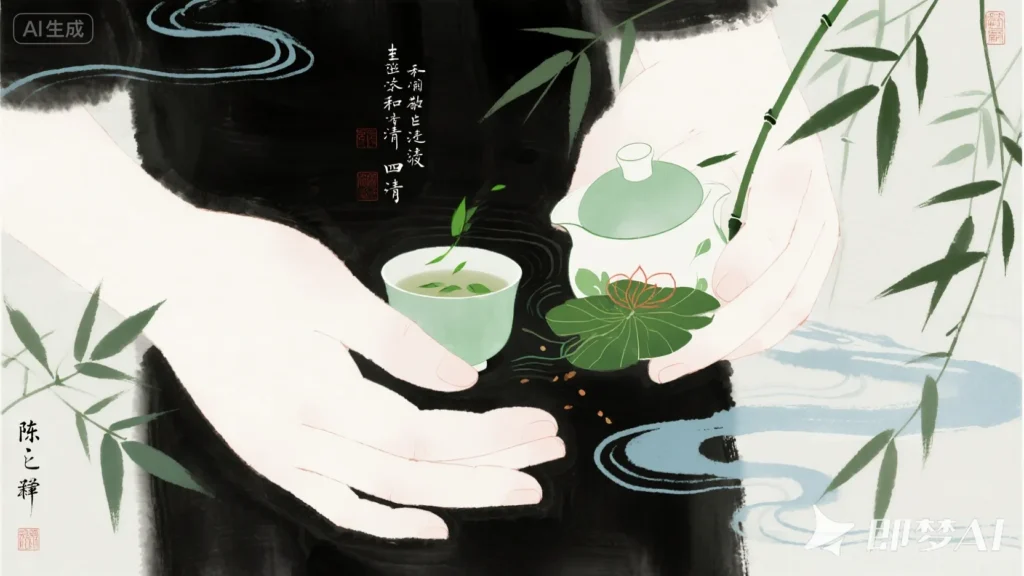
- Emphasizing Virtue: The Principle for Guiding One’s Relationship with Self “Emphasizing virtue” is the most fundamental part of the tea culture’s life values. The character of tea is the character of a person. Tea trees grow strong and deep in rocky mountains; tea leaves condense the essence of sunshine and rain, “their nature pure and not to be defiled”; tea soup is clear, crystal, and delightfully fragrant. These natural characteristics permeate life, guiding people to quietly observe, taste, and reflect on life, forming a realm, a concept, wisdom, and character. “Tea virtue” is the soul of the tea ceremony. Lu Yu, in “The Classic of Tea,” proposed “refined conduct and frugal virtue” , associating the excellent qualities of tea with people of noble character. Liu Zhenliang of the Tang Dynasty further summarized “ten tea virtues,” including “using tea to dispel melancholy” and “using tea to express respect,” concretizing the merits of tea drinking. Tea expert Mr. Zhuang Wanfang proposed “integrity, beauty, harmony, and respect” as the core tea virtues. All these point the way for tea practitioners to cultivate themselves and realize self-worth. Tea Sage Lu Yu’s lifelong disinterest in fame and fortune, his dedication to tea research, and his authorship of “The Classic of Tea,” embodying the spirit of “sacrificing oneself for the benefit of humanity,” perfectly exemplify the tea practitioner’s spirit.
- Advocating Harmony: The Purpose of Harmonizing Relationships with Others “Harmony” is the core philosophical idea of Chinese tea culture, running through the entire tea ceremony. It means harmony between humans and nature, and harmony between people. The “pure and harmonious” nature of tea inspires people to understand nature and treat the world with a “harmonious and beautiful” attitude. Lu Yu’s discussions in “The Classic of Tea” regarding the tea stove’s “Kan above, Xun below, Li in the middle” and “balancing the five elements to remove all diseases” were based on the philosophical ideas of “unity of heaven and humanity” and “balance of Yin and Yang.” The tea brewing process is a manifestation of the balanced interaction of the five elements: metal, wood, water, fire, and earth. In human relations and interpersonal interactions, “harmony” is reflected in “serving tea to guests, treating people with courtesy, and dealing with the world with sincerity.” A cup of clear tea symbolizes etiquette, sincerity, purity, and warmth, maintaining the affection between family and friends and promoting social harmony and stability.
- Honoring Frugality: The Basis for Managing Individual, National, and State Relations “Honoring frugality” is an important idea in tea culture regarding life values, advocating diligence, simplicity, and integrity in personal character and social conduct. Tea practitioners throughout history used tea as a medium to express emotions and concern for their country and people. Yan Ying, the prime minister of Qi, used tea to exemplify integrity. Lu Na and Huan Wen of the Jin Dynasty used tea to entertain guests, opposing extravagance. Lu Yu’s selection of tea sets also emphasized practicality rather than luxury, comparing tea to Yi Yin governing the state through cooking, entrusting his sincere heart of helping the world and worrying about the nation. In today’s society, the spirit of “fostering integrity through tea” still has profound practical significance for combating corruption and building a clean and thrifty society.
- Valuing Authenticity: The Requirement for Communicating with Nature “Valuing authenticity” is the core content of the Chinese tea ceremony and the ultimate pursuit of life values for tea practitioners, emphasizing intimacy between humans and nature and the pursuit of unity of truth, goodness, and beauty. Taoists believe that “authenticity is what one receives from heaven, natural and unchangeable,” emphasizing the consistency of “authenticity” with “heaven” and “nature.” The “authenticity” of tea has three meanings:
- The authenticity of tea’s natural properties: The pure, elegant, and simple natural qualities of tea leaves bring true fragrance, true taste, and true nature, true charm.
- The authenticity of the tea-tasting environment: Choosing natural environments that are wild, secluded, clear, and quiet, or accompanied by music, chess, calligraphy, and painting, to achieve a tea-tasting realm where “heavenly fun is fully present.”
- The authenticity of the tea practitioner’s temperament: Besides the external environment, what’s more important is the inner “empty and quiet” state of mind. An empty and quiet mind allows people to achieve spiritual purification and elevation during tea tasting, enjoying the joy of a leisurely and contented life, reaching “preserving one’s true nature.”
Human Flavors and Serene Joy in Tea Poetry
Ancient poets infused tea into their verses, making it full of everyday human flavors and tasting the elegant leisure and true taste.
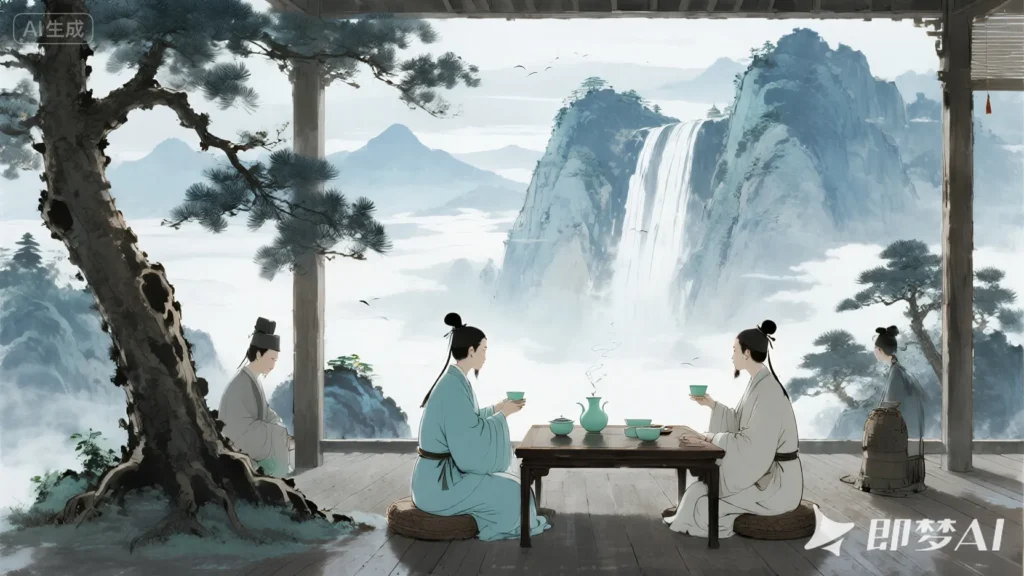
“What’s there to do in the mountains? Brew wine with pine flowers, boil tea with spring water.” (Zhang Kekiu, “Ren Yue Yuan · Mountain Writings”) This poem depicts the simple romance of having nothing to do in the mountains but brewing wine with pine flowers and boiling tea with spring water. The wisps of tea smoke and the faint aroma of wine make time slow down like a long song. Not chasing fame and fortune, just guarding a sense of tranquility is more precious than countless worldly splendors.
- “Snow foam and milk flowers float in the noon cup, smartweed shoots and bamboo shoots fill the spring plate. The true taste of life is serene joy.” (Su Shi, “Huan Xi Sha”) Su Shi and his friends tasted tea and fresh delights, with snow foam and milk flowers floating on the tea, accompanied by tender wild vegetables from the mountains. Without lavish delicacies, they tasted the true meaning of “the true taste of life is serene joy.” The flavors of life are often hidden in simplicity, not strong or intense, but most comforting to the heart.
- “On a cold night, a guest arrives, tea serves as wine, the bamboo stove’s water boils, the fire is just red.” (Du Lei, “Cold Night”) On a cold winter night, a guest arrives. There’s no need for wine; just boil a pot of hot tea. The fire is just red, tea smoke gently rises, and friends sit facing each other. A cup of hot tea warms the heart. True friendship is never about mere feasting but about the warmth of companionship and understanding on a cold night.
These tea poems show us how ancient people, through tea activities, discovered the beauty of life and enjoyed the serene joy of the moment in their ordinary routines.
Conclusion: One Cup of Tea, A Lifetime of Dao
From the rough brewing of ancient times to the refined boiling and whisking of the Tang and Song dynasties, and then to the clear steeping of the Ming and Qing dynasties, the evolution of tea is not only a progression in drinking methods but also an improvement in the quality of life and artistic pursuit for Chinese people. Tea culture, with its rich connotations, subtly influences the Chinese national spirit and has an impact worldwide.
A cup of tea is not only a physiological need but also a cultivation of the mind, a refinement of character, and a forging of personal strength. In an increasingly busy and competitive modern life, the spirit of “emphasizing virtue, advocating harmony, honoring frugality, and valuing authenticity” in tea culture still holds significant practical meaning. It helps balance people’s mindsets, resolve spiritual confusion, and enhance cultural literacy.
